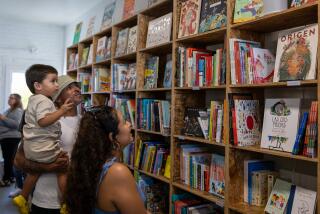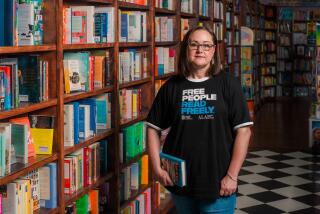Reading the Reader
Some folks remember their first pony ride; I remember my first bookcase. My father made it in the basement, and when he set it against the wall in my room, it was twice as tall as I, and the sudden sole possession of such a wide and high expanse of emptiness took my breath away. Using both hands, I filled it with books--my books--and when I was done, that bookcase seemed to me the most beautiful, precious thing I would ever own.
My very own library.
I still have it, have carted it around and across the country. It is dwarfed now by wider, higher models, but still it stands in my bedroom, one of the first things I see each morning. And sometimes I stand before it and run my fingertips along the beloved titles it holds and dream of my future library.
The two-story-high room would be lined with bookshelves, with a mezzanine running around the perimeter and, of course, a sliding ladder. It would be a place of rest and solace, perpetually lit by the amber light of late afternoon and the gentle glow from the tiled fireplace, with leather chairs large enough for my whole self, legs and feet included, and Persian carpets in burgundy and blue. And, of course, books--books from floor to ceiling, piled on tables and beside chairs, some precious books perhaps, a first-edition Proust, some signed Virginia Woolf, but mostly books one can actually read, and read again.
Henry Higgins’ library in “My Fair Lady,” say, or the children’s section at the downtown L.A. Central Public Library. Either one would do nicely, thank you.
It is my fantasy possession, my Rolls-Royce, my Italian villa, my string of matched pearls. A vision that reflects my future perfect self. A room that would be at once a thing of beauty and a haven. Which says, perhaps, more about me and my relationship with books, with the written word, than it does about anything else. But then, that is what a library will do--expose its creator, reveal his or her secret soul, the fantasies and fears, hopes and predilections. In our libraries, we catalog our friends and idols, harbor our secret journeys and nostalgia; the shelves that surround us hold our portals of escape. How many are they? Which are worn? Which tenderly kept? How close at hand do we need them? How often do we reach for one, or another?
Writers have long used the library to expose their characters (which has an odd, hall-of-mirrors quality to it--a book in a library in a book in a library.) The uncut volumes in Gatsby’s library revealed in an instant the sad and desperate nature of his quest. In “Bleak House,” Mr. Jarndyce retreats to his library like a badger to its den whenever the emotionally unstable wind from the east starts to blow.
*
Although libraries have existed since humans began their attempt to chronicle events and ideas, until the 1400s most of them were collective repositories for a city, a monastery or a university. One of the first private collections was begun in 15th century Florence by Cosimo de’ Medici. During the Renaissance in Europe, an increase in literacy was followed by a demand for books, a problem solved by Mr. Gutenberg, who rediscovered the ancient Asian development of movable type. The ownership of books became more a possibility for the individual.
But while most families in Europe, and later the United States, would have a shelf, or a chest, for precious tomes--their Bible, a copy of “Pilgrim’s Progress,” an almanac and other useful books on religion and medicine--the idea of a room devoted to books, many of them (gasp) novels, remained, until well into the 1800s, the province of the very rich. The requisite room such collections require aside, who else had the money to buy such books, or the education and free time to read them?
So for the poor, for the female, for the otherwise historically disenfranchised, the private library symbolized escape from the mundane brutality of real life--and providing access to such a library was the act of a savior, cementing instant and lifelong friendship.
In “Little Women,” Laurie’s place in Jo’s affections is sealed when she gets a glimpse of his grandfather’s library--the money be damned, give me the books. Even Disney’s “Beauty and the Beast” understands that a poor girl of spirit would rather have a library than all the jewels in the Tower. When Belle catches sight of the Beast’s ballroom lined with books, suddenly he seems not terribly beastly after all.
The enormous wave of immigration in this country during the 1800s created a huge demand for libraries--public and private--as thousands sought to learn English and the mores of a new land. A century later, the entrenching middle class began to create its own version of the private library--the family room or den.
Although TV soon would compete with the novels, biographies and encyclopedias for the family’s attention, the need and desire to possess one’s own books, to display them, to make them part of the environment remains. A house with no books visible would seem odd indeed. “Books are awfully decorative, don’t you think?” Patrick’s ditzy girlfriend pronounces on first meeting Auntie Mame.
“Books are the most intense reflection of someone’s personality,” says interior designer Kate Stamps. “They are like friends. There’s a security in having the books you’ve read around you, and the ones you haven’t. Those let you believe that there will be a tomorrow.”
The lucky few have free-standing libraries--a room in the house devoted to the lust of literati. The rest of us make our libraries where we can: In living rooms and dining rooms, in hallways and home offices, people find or make the space to display the books they love.
“They make a room instantly appealing, lived in, cozy,” says Stamps, who is adding a room onto her house simply because she and her husband and business partner Odom Stamps ran out of bookshelves. “With just a bookshelf, a good oil painting and an Oriental rug, you can have the world’s most lovely room.”
And while many of us cram another bookshelf behind a door or into a dim corner just because we can’t bear the thought of certain of our beloved books languishing in the garage, we make ourselves promises. Someday we will have shelves twice as tall as ourselves, walls of them, a flickering fire and deep comfy chairs and tables piled high. Someday we will have all the room in the world, and the absolutely perfect library.
*
Library by Stamps & Stamps Architecture, Interiors and Gardens, South Pasadena
More to Read
Sign up for our Book Club newsletter
Get the latest news, events and more from the Los Angeles Times Book Club, and help us get L.A. reading and talking.
You may occasionally receive promotional content from the Los Angeles Times.







